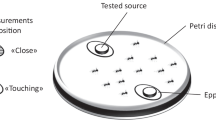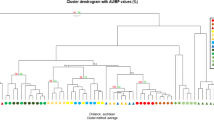Abstract
We analyzed the behavioral responses of the ants Camponotus rufipes and Solenopsis geminata towards all instars of Dione junio and Abananote hylonome. We also analyzed ant behavior towards hexane extracts of larvae and extracts of the spines and neck glands of the fifth instars of both species and identified the chemical compounds present. Larvae of both species were repellent to ants from the first instar onward. Later instars survived ant attacks better than earlier instars. The spines and neck glands of the larvae influenced the behavior of C. rufipes. The chemical compounds contained in the hexane extracts of whole first and fifth instars and in the spines and neck glands of fifth instars were principally carboxylic acids and terpenes. Further bioassays confirmed the repellent effect of some of these acids toward ants.
Similar content being viewed by others
REFERENCES
Attygalle, A. B., Meinwald, J., and Eisner, T. 1992. Defensive secretion of the carabid beetle, Helluomorphoides clairvillei. J. Chem. Ecol. 18:489–498.
Attygalle, A. B., Smedley, S. R., Meinwald, J., and Eisner, T. 1993. Defensive secretion of two notodontid caterpillars (Schizura unicornis, S. badia). J. Chem. Ecol. 19:2089–2104.
Bernays, E. A. 1988. Host specificity in phytophagous insects: Selection pressure from generalist predators. Entomol. Exp. Appl. 49:131–140.
Bernays, E. A., and Cornelius, M. L. 1989. Generalist caterpillar prey are more palatable than specialists for the generalist predator Iridomyrmex humulis. Oecologia 79:427–430.
Brower, L. P., Brower, J. V. Z., and Collins, C. T. 1963. Experimental studies on mimicry. 7. Relative palatability and Müllerian mimicry among neotropical butterflies of the subfamily Heliconiinae. Zool. N. Y. 48:65–84.
Brower, L. P., Brower, J. V. Z., and Corvino, J. M. 1967. Plant poisons in a terrestrial food chain. Proc. Natl. Acad. Sci. U.S.A. 57:893–898.
Brown, K. S., and Francini, R. B. 1990. Evolutionary strategies of chemical defense in aposematic butterflies: Cyanogenesis in Asteraceae-feeding American Acraeinae. Chemoecology 1:52–56.
Codella, S. G., and Raffa, K. F. 1995. Contributions of female oviposition patterns and larval behavior to group defense in conifer sawflies (Hymenoptera: Diprionidae). Oecologia 103:24–33.
Dani, F. R., Cannoni, S., Turillazzi, S., and Morgan, E. D. 1996. Ant repellent effect of the sternal gland secretion of Polistes dominulus (Christ) and P. sulcifer (Zimmerman) (Hymenoptera: Vespidae). J. Chem. Ecol. 22:37–48.
Deml, R., and Dettner, K. 1993. Biogenic amines and phenolics characterize the defensive secretion of saturnid caterpillars (Lepidoptera: Saturniidae): A comparative study. J. Comp. Physiol. B. 163:123–132.
Deml, R., and Dettner, K. 1994. Attacus atlas caterpillars (Lep., Saturniidae) spray an irritant secretion from defensive glands. J. Chem. Ecol. 20:2127–2138.
Deml, R., and Dettner, K. 1995. Effects of emperor moth larval secretions, hemolymph, and components on microorganisms and predators. Entomol. Exp. Appl. 76:287–293.
Dettner, K., and Leipert, C. 1994. Chemical mimicry and camouflage. Annu. Rev. Entomol. 39:129–154.
DeVries, P. J. 1987. The Butterflies of Costa Rica and Their Natural History. Princeton University Press, Princeton, New Jersey.
Dyer, L. A. 1995. Tasty generalists and nasty specialists? Antipredator mechanisms in tropical lepidopteran larvae. Ecology 76:1483–1496.
Dyer, L. A., and Flyod, T. 1993. Determinants of predation on phytophagous insects: the importance of diet breadth. Oecologia 96:575–582.
Eisner, T. F., Kluge, K. F., Carrel, J. C., and Meinwald, J. 1972. Defensive mechanisms of arthropods. XXXIV. Formic acid and acyclic ketones in the spray of a caterpillar. Ann. Entomol. Soc. Am. 65:765–766.
Franzl, S., and Naumann, C. M. 1985. Cuticular cavities: Storage chambers for cyanoglucoside containing cavities in larvae of a zygaenid moth. Tissue Cell. 17:267–278.
HernÁndez, J. V. 1996. Ecología química del comportamiento agnóstico de Atta laevigata (Hymenoptera: Formicidae). PhD thesis. Universidad Simon Bolivar, Caracas.
Honda, K. 1981. Larval osmeterial secretions of the swallowtails (Papilio). J. Chem. Ecol. 7:1089–1113.
Honda, K. 1983. Defensive potential of components of the larval osmeterial secretion of papilionid butterflies against ants. Physiol. Entomol. 8:173–179.
Howard, D. F., Blum, M. S., Jones, T. H., and Phillips, D. W.. 1982. Defensive adaptions of eggs and adults of Gastrophysa cyanea (Coleoptera: Chrysomelidae). J. Chem. Ecol. 8:453–462.
Jaffe, K., Mauleon, H., and Kermarrec, A. 1991. Qualitative evaluation of ants as biological control agents with special reference to predators on Diaprepes spp. (Coleoptera: Curculionidae) in citrus groves in Martinique and Guadeloupe, pp. 405–416, in C. Pavis and A. Kermarrec (eds.). Rencontres Caraibes en Lutte Biologique, INRA, Paris.
Montllor, C. B., Bernays, E. A., and Cornelius, M. L. 1991. Responses of two hymenopteran predators to surface chemistry of their prey: Significance for an alkaloid-sequestering caterpillar. J. Chem. Ecol. 17:391–399.
Nahrstedt, A., and Davis, R. H. 1983. Occurrence, variation and biosynthesis of the cyanogenic glucosides linamarin and lotaustralin in species of the Heliconiini (Insecta: Lepidoptera). Comp. Biochem. Physiol. 75B:65–73.
Nahrstedt, A., and Davis, R. H. 1985. Biosynthesis and quantitative relationships of the cyanogenic glucosides linamarin and lotaustralin in genera of the Heliconiini (Insecta: Lepidoptera). Comp. Biochem. Physiol. 82B:745–749.
Nickisch-Rosenegk, E. VON, and Wink, M. 1993. Sequestration of pyrrolizidine alkaloids in several arctiid moths (Lepidoptera: Arctiidae). J. Chem. Ecol. 19:1889–1903.
Nowbahari, B., and Thibout, E. 1992. Defensive role of Allium sulfur compounds for leek moth Acrolepiopsis assectella Z. (Lepidoptera) against generalist predators. J. Chem. Ecol. 18:1991–2002.
Pavis, C., Maloose, C., Ducrot, F., Howse, P. E., Jaffe, K., and Descoins, C. 1992. Defensive secretion of first-instar larvae of rootstalk borer weevil, Diaprepes abbreviatus L. (Coleoptera: Curculionidae), to the fire-ant Solenopsis geminata (F.) (Hymenoptera: Formicidae). J. Chem. Ecol. 18:2055–2067.
Perfecto, I. 1991. Ants (Hymenoptera: Formicidae) as natural control agents of pests in irrigated maize in Nicaragua. Environ. Entomol. 84:65–70.
Reimann, H. 1983. Chemische Zusammensetzung und Wirksamkeit des Wehreskretes der Larven von Zygaena trifoloo (Esper. 1793). Lepidoptera. Staatsexamensarbeit. University of Bielefeld.
Risch, S. J., and Carroll, C. R. 1982a. The ecological role of ants in two Mexican agroecosystems. Oecologia 55:114–119.
Risch, S. J., and Carroll, C. R. 1982b. Effect of a keystone predaceous ant, Solenopsis geminata, on arthropods in a tropical agroecosystem. Ecology 63:1979–1983.
Rockstein, M. 1978. Biochemistry of Insects. Academic Press, 649 pp.
Siegel, S., and Castellan, N. J. 1988. Nonparametric Statistics for the Behavioral Sciences, 2nd ed. McGraw-Hill, New York.
Sokal, R. R., and Rohlf, F. J. 1981. Biometry. W. H. Freeman, San Francisco.
Vulinec, K. 1990. Collective security: aggregation by insects as a defense, pp. 251–288, in D. L. Evans and J. O. Schmidt (eds.). Insect Defenses: Adaptive Mechanisms and Strategies of Prey and Predators. State University of New York Press, Albany.
Way, M. J., and Khoo, K. C. 1992. Role of ants in pest management. Annu. Rev. Entomol. 37:479–503.
Weatherston, J., Percy, J. E., MacDonald, L. M., and MacDonald, J. A. 1979. Morphology of the prothoratic defensive gland of Schizura concinna (Lepidoptera: Notodontidae) and the nature of its secretion. J. Chem. Ecol. 5:165–178.
Weseloh, R. M. 1989. Simulation of predation by ants based on direct observations of attacks on gypsy moth larvae. Can. Entomol. 121:1069–1076.
Author information
Authors and Affiliations
Rights and permissions
About this article
Cite this article
Osborn, F., Jaffe, K. Chemical Ecology of the Defense of Two Nymphalid Butterfly Larvae Against Ants. J Chem Ecol 24, 1173–1186 (1998). https://doi.org/10.1023/A:1022494802266
Issue Date:
DOI: https://doi.org/10.1023/A:1022494802266




